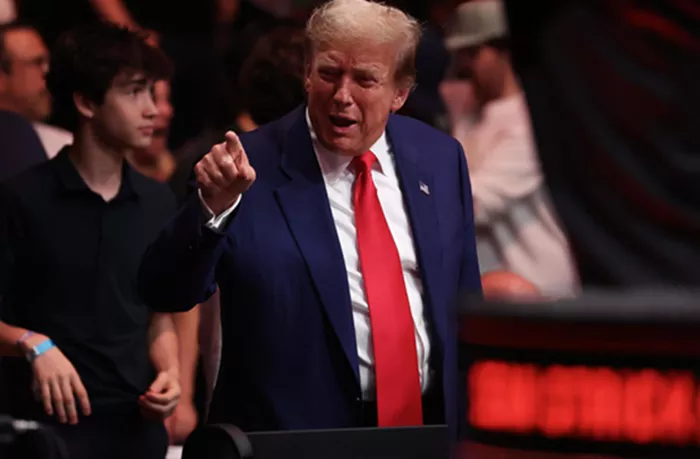President-elect Donald Trump has made it clear that his administration will prioritize aggressive trade policies, particularly targeting the United States’ three largest trading partners: Canada, Mexico, and China. In a move that has raised alarms over potential trade wars, Trump unveiled a plan to impose substantial tariffs on imports from these countries, with the goal of addressing what he perceives as critical issues surrounding illegal immigration, drug trafficking, and unfair trade practices.
Trump’s tariff proposal on Canada and Mexico aims to tackle drug smuggling, particularly fentanyl, as well as the ongoing issue of illegal border crossings. On Monday, Trump pledged to impose a 25% tariff on all goods coming from Canada and Mexico, a drastic move that would almost certainly violate the provisions of the United States-Mexico-Canada Agreement (USMCA), which was implemented in 2020 to continue largely duty-free trade between the three nations. Trump’s promise to impose these tariffs is intended to pressure Mexico and Canada to do more to curb the flow of illicit drugs and curb illegal immigration into the U.S.
The President-elect posted on Truth Social, “On January 20th, as one of my first Executive Orders, I will sign all necessary documents to charge Mexico and Canada a 25% Tariff on ALL products coming into the United States, and its ridiculous Open Borders.” This move would not only escalate tensions with both neighboring countries but could have far-reaching consequences for global trade, particularly with industries that rely heavily on cross-border production, such as the auto and electronics sectors, many of which use Mexico as a low-cost manufacturing hub for the U.S. market.
In 2023, over 83% of Mexico’s exports went to the U.S., while Canada also heavily relies on the U.S. market, with 75% of its exports destined for America. A tariff of this scale would increase prices for American consumers, potentially disrupting supply chains and driving up inflation. Furthermore, Trump’s move would likely provoke retaliation from both countries, destabilizing trade relations and further straining the North American economy.
The USMCA, which Trump himself signed into law, includes provisions to prevent the imposition of unilateral tariffs between member nations. The agreement was hailed as a success in facilitating trade among the three countries, but Trump’s new tariff proposal could spark an early renegotiation. While the USMCA has a “sunset” clause that would require renegotiation by 2026, Trump’s tariff threats seem aimed at accelerating the process, forcing Canada and Mexico to agree to new terms sooner than anticipated.
After announcing the tariff plans, Trump spoke with Canadian Prime Minister Justin Trudeau to discuss trade and border security. A source familiar with the conversation described it as a “good discussion,” although it remains unclear whether it will result in any tangible changes to the USMCA or alter Trump’s plans for January.
William Reinsch, a former president of the National Foreign Trade Council, speculated that Trump might be using the threat of tariffs as leverage to force an early renegotiation of the trade deal. “This strikes me more as a threat than anything else,” Reinsch commented. “I guess the idea is if you keep hitting them in the face, eventually they’ll surrender.”
Trump also set his sights on China, accusing Beijing of failing to curb the flow of fentanyl and other illicit drugs into the United States. As part of his broader economic agenda, he announced an additional 10% tariff on Chinese goods, saying, “Until such time as they stop, we will be charging China an additional 10% Tariff, above any additional Tariffs, on all of their many products coming into the United States of America.”
The Chinese government quickly responded, with a spokesperson arguing that trade between the U.S. and China is mutually beneficial and emphasizing that China has already taken steps to limit the export of fentanyl precursors, as agreed in a 2023 meeting between the two countries. Liu Pengyu, the Chinese embassy spokesperson, countered that the assertion of China enabling fentanyl trafficking is “completely counter to facts and reality.” This suggests that the tariff dispute could further strain relations, with Beijing vowing not to back down in the face of increased tariffs.
Trump’s rhetoric on China has been consistent since his first presidential campaign, where he promised to end China’s most-favored-nation status and impose tariffs of up to 60% on Chinese goods. With the Chinese economy facing significant challenges, including a prolonged property downturn and growing debt concerns, the potential for a full-scale trade war could have severe consequences for both countries’ economies.
Economists are warning that Trump’s proposed tariffs could have significant implications for the U.S. economy. If implemented, these measures would push import duty rates to levels not seen since the 1930s, potentially stoking inflation and driving up the cost of consumer goods. Companies importing goods from Mexico, Canada, and China would face higher costs, which they would likely pass on to consumers in the form of higher prices. As a result, American families could feel the sting of rising costs on everyday items, from electronics to food products.
Additionally, the tariffs would likely trigger retaliatory measures from affected countries, further escalating the trade war. Mexico and Canada could impose their own tariffs on U.S. goods, and China, already a key player in global trade, could seek to reduce its reliance on American imports, shifting its focus to other markets.
While Trump has claimed that the tariffs will be paid by the foreign governments, economists argue that, in reality, it will be American consumers who bear the brunt of the cost. As Trump prepares to take office on January 20, 2025, the direction of U.S. trade policy will likely be one of the most closely watched aspects of his administration. The world is waiting to see whether his tariff-heavy approach will lead to a more isolationist U.S. economy or prompt a broader global economic realignment.
Read more:
COP29’s Climate Finance Deal: A Disastrous Outcome For Human Rights And Global Equity
What Is a Viable Method of Separating Gasoline from Crude Oil?

